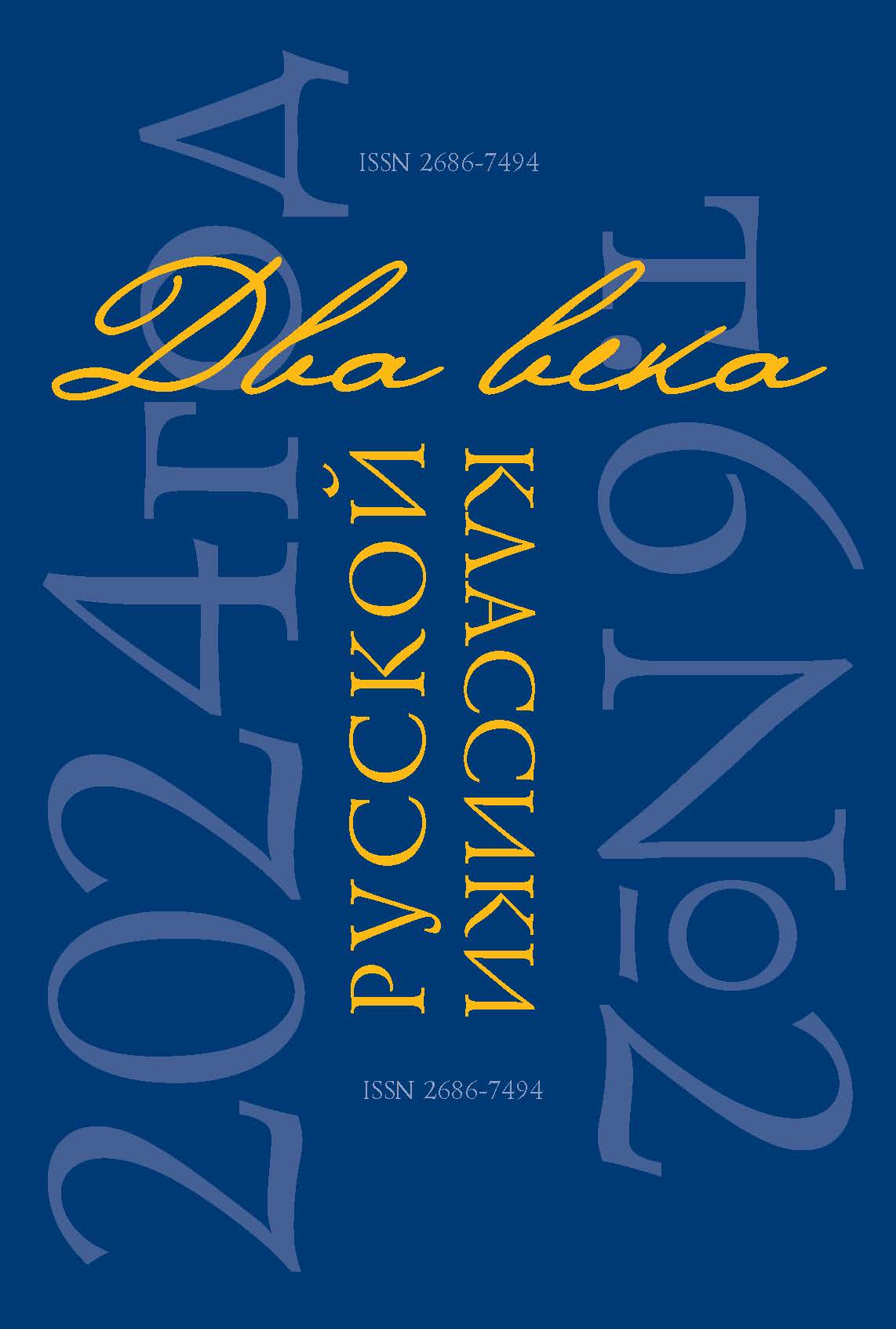Abstract:
The article examines parallels in plot and images between Ostrovsky’s drama “Without a Dowry” and Dostoevsky’s novel “Demons.” Ostrovsky’s remarks about Dostoevsky in the last years of his life reveal that he distanced himself from the creative principles of the author of “Demons.” However, gestures and remarks of the characters of “Without a Dowry,” such as Paratov, Vozhevatov, Larisa Ogudalova, as well as motifs and collisions connected with them allow us to suggest that while working on the drama, Ostrovsky was influenced by a “literary recall” of Dostoevsky’s novel “Demons” and its characters, namely Stavrogin, Petr Verkhovensky, Liza Tushina. The possible parallels between the characters in “Without a Dowry” and “Demons” are also indicated by their common biblical and literary prototypes: there are allusions to the Serpent-temtper, Hamlet, Prince Harry, Mephistopheles and Faust contained in the stories of Stavrogin and Paratov, allusions to the Serpent and Mephistopheles in the gestures and actions of Petr Verkhovensky and Vozhevatov, while allusions to Ophelia, Gretchen and Poor Liza can be found in the images of Liza Tushina and Larisa Ogudalova. Even despite the differences in the writers’ approaches, there are remarkable plot parallels between the two works, common components in the characters’ images, similar artistic techniques, which, in our opinion, are signs of a literary “dialogue” between the authors of “Demons” and “Without a Dowry.”
References
Al’mi, I. L. “Dostoevskii i Ostrovskii: smysl ideologicheskikh sopriazhenii; grani tipologicheskoi blizosti” [“The Meaning of Ideological Conjunctions; the Facets of Typological Closeness]. Al’mi, I. L. Vnutrennii stroi literaturnogo proizvedeniia [The Inner Structure of a Literary Work]. St. Petersburg, Skifiia Publ., 2009, pp. 272–286. (In Russ.)
Budanova, N. F. “Primechaniia” [“The Notes”]. Dostoevskii, F. M. Sobranie sochinenii: v 15 t. [Collected Works: in 15 vols.], vol. 7. Leningrad, Nauka Publ., 1990, pp. 675–708. (In Russ.)
Bem, A. L. “Sumerki geroia (Etiud k rabote: Otrazhenie ʽPikovoi damy’ v tvorchestve F. M. Dostoevskogo)” [“Twilight of the Hero (A Study for the Work Reflection of ʽThe Queen of Spades’ in Dostoevsky’s Work)”]. “Besy”: antologiia russkoi kritiki [“Demons”: An Anthology of Russian Criticism], comp. by L. Saraskina. Moskow, Soglasie Publ., 1996, pp. 662–667. (In Russ.)
Ivanov, V. I. Po zvezdam. Borozdy i mezhi [By the Stars. Furrows and Boundaries]. Moskow, Astrel’ Publ., 2007. 1137 p. (In Russ.)
Karpushkina, L. “Shekspirovskie motivy sorokovogo opusa. Ironicheskii podtekst v p’ese ʽBespridannitsa’.” [“Sheakspearan Themes in ʽOpus Forty.’ The Ironic Subtext of ʽWithout a Dowry’.”]. Voprosy literatury, no. 2, 2016, pp. 157–170. (In Russ.)
Krinitsyn, A. B. “Shekspirovskie motivy v romane F. M. Dostoevskogo ‘Besy’.” [“Shakespearean Motifs in Dostoevsky’s Novel ʽDemons’.”]. K 60-letiiu professora Anny Ivanovny Zhuravlevoi: sbornik statei [To the 60th Anniversary of Professor Zhuravleva: Collection of Articles]. Moscow, Dialog-MGU Publ., 1998, pp. 161–173. (In Russ.)
Krinitsyn, A. B. “Povest’ ʽBednaia Liza’ N. M. Karamzina v tvorchestve F. M. Dostoevskogo” [“Karamzin’s Story ʽPoor Liza’ in Dostoevsky’s Work”]. Vestnik Moskovskogo universiteta. Seriia 9: Filologiia, no. 1–2, 2017, pp. 102–116. (In Russ.)
Lakshin, V. “Ostrovskii (1878–1886)” [“Ostrovsky (1878–1886)”]. Ostrovskii, A. N. Polnoie sobranie sochinenii: v 12 t. [Complete Works: in 12 vols], vol. 5. Moscow, Iskusstvo Publ., 1975, pp. 475–498. (In Russ.)
Meletinskii, E. M. Zametki o Dostoevskom [Notes on Dostoevsky]. Moscow, Russian State University for Humanities Publ., 2001. 190 p. (In Russ.)
Mikhnovets, N. G. “ʽGroza’ — ʽKrotkaia’ — ʽBespridannitsa’: istoriia metasiuzheta i problema postizheniia fakta deistvitel’nosti” [“ʽThe Storm’ — ʽA Gentle Creature’ — ʽWithout a Dowry’: The History of Meta-Story and the Problem of Understanding the Fact of Reality”]. Pechat’ i slovo Sankt-Peterburga: Peterburgskie chteniia 2012. Chast’ II: Literaturovedenie [The Press and the Word of St. Petersburg. Petersburg Readings 2012. Part 2: Literary Studies]. St. Petersburg, Petersburg Institute of Printing Publ., 2013, pp. 100–112. (In Russ.)
Mikhnovets, N. G. “F. M. Dostoevskii i A. N. Ostrovskii v protsesse poznaniia naroda (1860-e gg.)” [“F. M. Dostoevsky and A. N. Ostrovsky in the Process of Learning about the People (1860s)”]. Vestnik Sankt-Peterburgskogo universiteta. Iazyk i literatura, no. 3, 2021, pp. 460–478. https://doi.org/10.21638/spbu09.2021.303 (In Russ.)
Mokina, N. V. “Motiv vesel’ia i funktsii smekha v proizvedeniiakh Ostrovskogo i Chekhova” [“The Motif of ʽMerriment’ and the Functions of the Laugh in the Works by Ostrovsky and Chekhov”]. A. P. Chekhov i A. N. Ostrovskii. Po materialam piatykh mezhdunarodnykh Skaftymovskikh chtenii [A. P. Chekhov and A. N. Ostrovsky. Materials of the 5th International Skaftymovsky Readings]. Moscow, A. A. Bakhrushin State Central Theatre Museum Publ., 2020, pp. 297–317. (In Russ.)
Nazirov, R. G. “O prototipakh nekotorykh personazhei Dostoevskogo” [“About the Prototypes of Some of Dostoevsky’s Characters”]. Dostoevskii: materialy i issledovaniia [Dostoevsky. Materials and Research], vol. 1. Leningrad, Nauka Publ., 1971, pp. 202–219. (In Russ.)
Nazirov, R. G. “Materialy k monografii o romane F. M. Dostoevskogo ʽBesy’.” [“The Materials for the Monograph about Dostoevsky’s Novel ʽDemons’.”]. Nazirovskii arkhiv, no. 2, 2013, pp. –7-83. URL: http://nevmenandr.net/nazirov/journal.php (Accessed 10 April 2023). (In Russ.)
Panchenko, A. M. Ia emigriroval v Drevniuiu Rus’ [I Emigrated to Ancient Rus]. St. Petersburg, Zvezda Publ., 2008. 544 p. (In Russ.)
Prokhorov, E. I. “Kommentarii” [“Comments”]. Ostrovskii, A. N. Polnoe sobranie sochinenii: v 12 t. [The Complete Works: in 2 vols.], vol. 5. Moscow, Iskusstvo Publ., 1975, pp. 499–507. (In Russ.)
Tarasova, N. A. “ʽKrotkaia’ F. M. Dostoevskogo i ʽBespridannitsa’ A. N. Ostrovskogo v tekstologicheskom aspekte” [“ʽA Gentle Creature’ by F. M. Dostoyevsky and ʽWithout a Dowry’ by A. N. Ostrovsky in the Textological Aspect”]. Filologicheskie nauki, no. 6, 2008, pp. 4–13. (In Russ.)
Tunimanov, V. A. “Rasskazchik v ʽBesakh’ Dostoevskogo” [“The Narrator in the ʽDemons’ by Dostoevsky”]. Issledovaniia po poetike i stilistike [Research on Poetics and Stylistics]. Leningrad, Nauka Publ., 1972, pp. 87–162. (In Russ.)
Chernets, L. V. “Tipy ʽsamodura’ i ʽdelovogo cheloveka’ v p’esakh A. N. Ostrovskogo” [“Types of a ʽDespot’ and a ʽBusiness Man’ in Ostrovsky’s Plays”]. Nasledie A. P. Skaftymova i aktual’nye problemy izucheniia otechestvennoi dramaturgii i prozy [The Legacy of Skaftymov and Actual Problems of the Study of Domestic Drama and Prose]. Moscow, A. A. Bakhrushin State Central Theatre Museum Publ., 2015, pp. 73–86. (In Russ.)
Chirkov, N. M. O stile Dostoevskogo. Problematika, idei, obrazy [About Dostoevsky’s Style. Problems, Ideas, Images]. Moscow, Nauka Publ., 1967. 303 p. (In Russ.)









